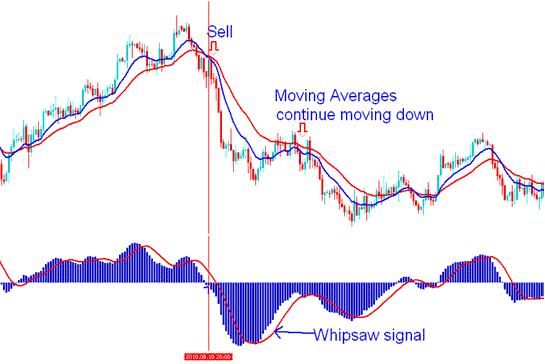MACD Commodity Trading Whipsaws and Fake Out Signals on Bearish & Bullish Territory
Since the MACD indicator is a leading indicator which sometimes gives whipsaws, we shall look at an example of a commodity whipsaw generated by this MACD indicator, so as to illustrate why it's always good to wait for a confirmation trading signal.

MACD Technical Indicator Commodity Trading Whipsaw - Commodity Trading Whipsaws
The MACD indicator gave a buy signal, when this buy signal was generated and the MACD indicator line was still below the zero center line mark. At this point the buy signal had not been confirmed and it resulted into a commodity whipsaw as illustrated by the moving averages which continued to move downwards.
A commodity whipsaw signal is as a result of dramatic rise and fall in the price in a short time and in such a manner that skews the data used in calculating the moving averages that draw the MACD indicator data. These types of whipsaw moves are usually brought about because of some news event that can produce market noise.
Traders should have the ability to gauge a commodity whipsaw and withstand the whipsaw; a commodity whipsaw might result into an upswing session and then a downswing session. To minimize the risk of trading commodity whipsaws, it's good to wait for confirmation of commodity signals by waiting for MACD to cross above or below the zero center-line mark.
Combining MACD Crossover with Center-Line Crossover to Prevent Commodity Trading Whipsaws
Buy trading signal - When there is a cross-over, followed by a steep rise in price and then a center-line crossover the buy signal is confirmed.
Sell trading signal - When there is a cross-over, followed by a steep decline in price and then a center-line crossover the sell commodity signal is confirmed.
1. Buy Trading Signal in Bearish Territory Whipsaw
When a buy signal is generated in a bearish territory, it may result into a commodity whip saw especially if it is not followed soon by a MACD center line crossover.
In the commodity example portrayed & described below, MACD indicator gives a buy signal even though it is in bearish territory, the MACD indicator then turns downwards and starts moving down again resulting into a commodity whipsaw. By waiting for center line crossover it is possible to avoid the whipsaw.
However, in this case there was a brief center line crossing: this commodity whipsaw would have been hard to trade using this MACD indicator alone, that is why it is good to combine the use of MACD indicator with another commodity technical indicator. In the commodity example illustrated and explained below MACD is combined with the moving average commodity indicators technical analysis.

MACD Commodity Whipsaw - Buy Signal in Bearish Territory
2. Sell Signal in Bullish Territory Whipsaw
When a sell commodity signal is generated in a bullish territory, it may result into a commodity whip saw especially if it is not followed soon by a MACD center-line crossover.
In the commodity example portrayed & described below, the MACD indicator gives a sell commodity signal even though it is in bullish territory, the MACD indicator then turns up and starts moving upwards again resulting into a commodity whipsaw. By waiting for center-line crossover it is possible to avoid the commodity whipsaw. In the commodity example illustrated and explained below by combining this MACD indicator with the MA Cross Over Commodity Strategy you would have avoided this whipsaw.

MACD Commodity Whipsaw - Sell Signal in Bullish Territory
To avoid commodity whipsaws completely when trading the commodity market with this MACD Indicator it is best to use the Center-line Crossover Signal as the Official Buy or Sell Trading Signal of The MACD Indicator.


